Sustainable Farming magazine Fall 2019 (Volume 4, Issue 4)
News: Pig Out – Feeding For Health and Welfare Opinion: Farmers United Cover feature: Feeding Pigs Technical: Housing Benefits Technical: Working With Your Vet Technical: Kid You Not Technical: Grassfed Challenges Meet the Farmer: TLC Grassfed Beef in Enid, OK
News: Pig Out – Feeding For Health and Welfare
Opinion: Farmers United
Cover feature: Feeding Pigs
Technical: Housing Benefits
Technical: Working With Your Vet
Technical: Kid You Not
Technical: Grassfed Challenges
Meet the Farmer: TLC Grassfed Beef in Enid, OK
- No tags were found...
Create successful ePaper yourself
Turn your PDF publications into a flip-book with our unique Google optimized e-Paper software.
BEANA BERN<br />
BEANA BERN<br />
Example alternative feeds<br />
and their contribution to the diet<br />
Whey: If whey is available, gradually encourage<br />
the pigs to take up to 2 gallons whey per<br />
pig per day. This will reduce the amount of<br />
required concentrate feed by around 2 pounds<br />
per pig per day.<br />
Vegetable waste: Around 11 pounds fresh<br />
weight of vegetables, such as apples, swedes,<br />
squash or zucchini, can replace 1 pound of<br />
concentrate feed. However, it is important that<br />
vegetables do not exceed 20% of the total<br />
ration on a dry matter basis. For example, if<br />
a pig is eating around 5 pounds of concentrate<br />
feed a day, it should receive a maximum of<br />
1 pound of vegetables on a dry matter basis<br />
(around 6–7 pounds fresh weight) per day.<br />
The remainder must come from concentrate<br />
feed to maintain growth and health.<br />
Pigs will readily eat waste vegetables but the nutritional value is minimal<br />
that one acre of good pasture can support up<br />
to eight dry sows, or 15–30 pigs less than 100<br />
pounds, or 10–20 pigs over 100 pounds, although<br />
time of the year, soil type/fertility, pasture quality<br />
and composition and rainfall will all affect these<br />
estimates. The way the pasture is used—strip<br />
grazing, rotational grazing or set stocking—will also<br />
have an impact on how much feed value pigs will<br />
get, and how long they can be maintained on a<br />
certain area. (The prolonged use of the same area<br />
of pasture or crops can quickly lead to a build-up<br />
of parasites and should be avoided anyway.)<br />
It is important to note that the nutritional<br />
value of pasture will change over time, as it is<br />
either denuded, matures or is affected by climatic<br />
conditions. If pasture is used to replace part of<br />
a concentrated feed, the levels of additional<br />
supplemental feed will need constant adjusting<br />
based on pasture condition and the pigs’<br />
nutritional needs.<br />
Silage or baleage can also be used for feeding<br />
pigs, although these feeds are best utilized by dry<br />
sows and finishing pigs. Forages should be cut and<br />
preserved when the pasture is young and leafy,<br />
and pigs will need an adaptation period of several<br />
weeks to get the best results.<br />
Diverse mixtures of forages will give the best<br />
results. Pig management texts from the early 20th<br />
century suggest that a mixture of grass, oats, clover,<br />
peas and turnips can help to reduce the quantity<br />
of concentrate feed needed to fatten pigs. If such<br />
mixtures are grazed, good pasture management<br />
will be essential to ensure pigs are eating the<br />
forage and not just rooting and destroying it.<br />
Remember: Allowing pigs to forage without any<br />
supplementary feed OR feeding silage or baleage<br />
alone will not meet the pigs’ full nutritional needs.<br />
Additional concentrate feed (and any necessary<br />
mineral supplementation) will be necessary in<br />
order to maintain condition and health.<br />
Alfalfa<br />
Alfalfa’s nutritional quality varies with stage of<br />
maturity and soil fertility, as well as method of<br />
harvesting, handling and storage. Compared to<br />
grains, alfalfa has around half the level of digestible<br />
energy. The more mature alfalfa is at the time of<br />
grazing or cutting, the lower its nutritional value.<br />
Alfalfa also contains tannins and sapponins—<br />
anti-nutritional factors that reduce the growth<br />
rate of pigs.<br />
Alfalfa can be a valuable feed for dry sows,<br />
but less so for younger pigs. Sows have a greater<br />
capacity for fermentation in the hindgut that allows<br />
for greater fiber digestion and improved energy<br />
utilization. Additionally, studies at the University<br />
of Minnesota showed increased litter size and<br />
lactation feed intake when sows were fed alfalfa<br />
haylage during gestation.<br />
Human food waste<br />
Some pig farmers have access to bakery waste<br />
or similar products. While these feeds may be<br />
low cost (or even free), they will have limited feed<br />
value. Similarly, while waste vegetables such as<br />
squash, pumpkin and zucchini will be readily eaten<br />
by pigs, the nutritional value is minimal. (See box.)<br />
Such feeds should only be considered as a treat<br />
“AGW<br />
standards<br />
require<br />
farmers<br />
who replace<br />
concentrate<br />
feed to<br />
employ<br />
a swine<br />
nutrition<br />
expert to<br />
verify that<br />
amended<br />
diets meet<br />
the pigs<br />
needs”<br />
Feeds like squash should only be considered as a treat or supplement<br />
or supplement to high-quality grain and protein<br />
feeds—and never the pigs’ main diet.<br />
Seek expert advice<br />
Alternative feeds can make a positive contribution<br />
to the diet of certain types of pigs and at different<br />
stages of the production cycle. However, alternative<br />
feeds will rarely—if ever—meet the pig’s dietary<br />
needs in full and supplementary grain and protein<br />
feeds are necessary for efficient growth and health.<br />
It is essential to fully assess the type of feed and<br />
the type of pig before new feeds are introduced.<br />
Farmers should never expect to completely<br />
eliminate concentrate feeds from the pigs’ diet<br />
and any reduction in their use should be planned<br />
with a nutritionist to ensure pig health and welfare<br />
is maintained. The Certified Animal Welfare<br />
Approved by AGW program requires farmers who<br />
intend to replace concentrate feed with alternative<br />
feeds to employ a swine nutrition expert to verify<br />
that any amended diets will meet the needs of<br />
their pigs.<br />
Anna Heaton is Lead Technical Advisor with<br />
A Greener World. Tim Holmes is Director of<br />
Compliance with A Greener World<br />
Further information<br />
Shurson, Jerry et al (2002). Designing Feeding Programs for<br />
Natural and Organic Pork Production. St Paul, MN: University of<br />
Minnesota Extension Service. http://hdl.handle.net/11299/48800.<br />
Edwards, Sandra (2020). Feeding Organic Pigs: A handbook<br />
of raw materials and recommendations for feeding practice.<br />
School of Agriculture Food & Rural Development: University<br />
of Newcastle. http://www.britishpigs.org.uk/Newcastle_<br />
handbook_of_raw_materials.pdf<br />
Potatoes: Approximately 6½–7 pounds of<br />
raw potatoes will replace 1 pound of barley,<br />
with additional protein supplementation<br />
required. Dry sows can easily meet their daily<br />
energy requirements from raw potatoes fed<br />
ad libitum, with a small amount of protein<br />
supplement. For finishing pigs, raw potatoes<br />
can comprise up to 25% of the diet on a dry<br />
matter basis, although performance is likely<br />
to be reduced relative to cereal diets. Potatoes<br />
should not be considered for weaner and<br />
growing pigs unless they are cooked, due to<br />
their relatively low palatability and high bulk.<br />
How much should I feed?<br />
Overall: As a general rule of thumb, 1 pound<br />
of feed per pig per day for every month of age<br />
works well for fattening pigs, with a maximum<br />
of 5-6 pounds depending on how well the<br />
pig has grown. This amount can be reduced<br />
if you are offering lots of vegetables or other<br />
supplementary feed, such as whey, as per the<br />
guidelines above.<br />
Sows: Sows that are in pig and not lactating<br />
(dry) require around 4–5 pounds of feed<br />
per day. In winter, this can be increased to<br />
6 pounds, if needed. Sows that have farrowed<br />
can have their feed increased by around<br />
1 pound per day after farrowing (assuming<br />
she will eat it). The maximum amount depends<br />
on number of piglets, which can be up to<br />
2 pounds per piglet reared. Remember that<br />
once the piglets are around two weeks old<br />
they will start eating some feed. This should<br />
be encouraged as it will help them when they<br />
are weaned.<br />
POTATOES: VM/ISTOCK<br />
10 • SUSTAINABLE FARMING • FALL <strong>2019</strong><br />
FALL <strong>2019</strong> • SUSTAINABLE FARMING • 11


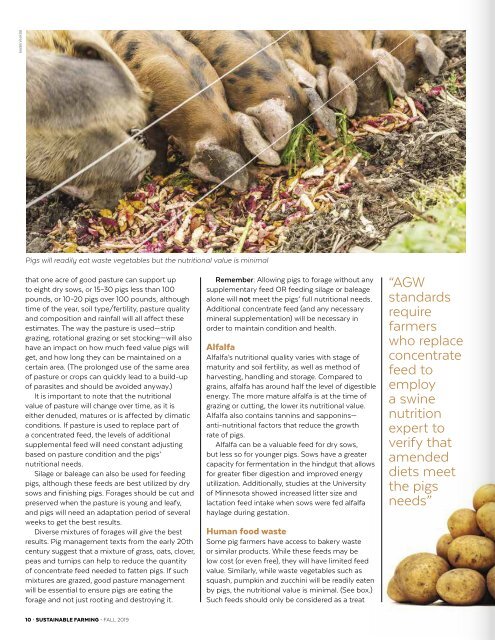

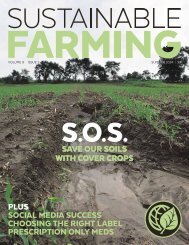
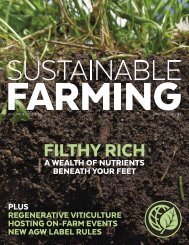
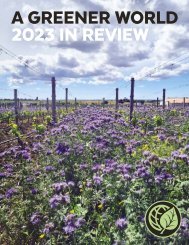
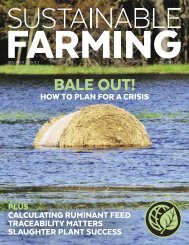

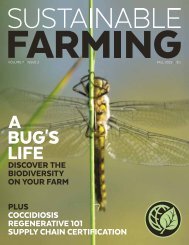
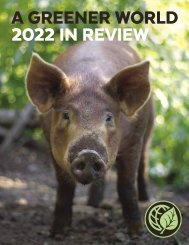
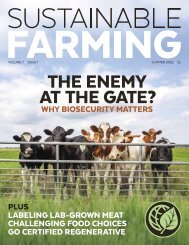
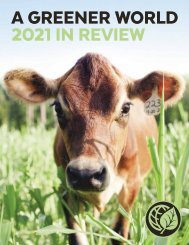
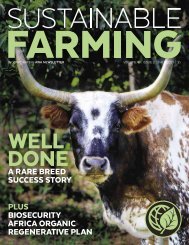




![SF Magazine V5 I1 -- Winter-Spring 2020 [SCREEN ONLY]](https://img.yumpu.com/63122871/1/190x245/sf-magazine-v5-i1-winter-spring-2020-screen-only.jpg?quality=85)